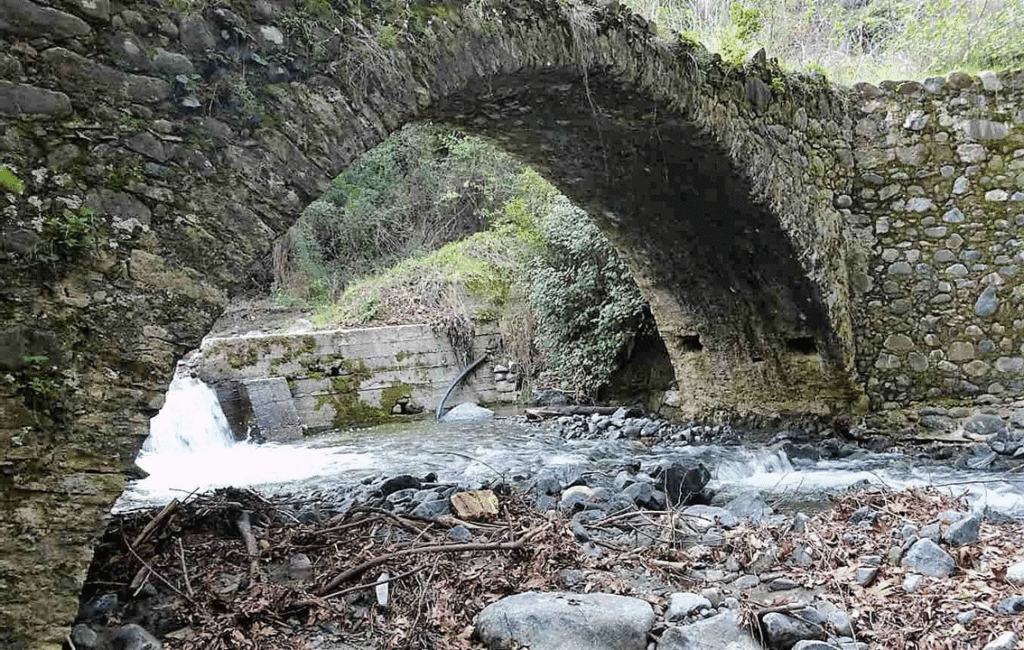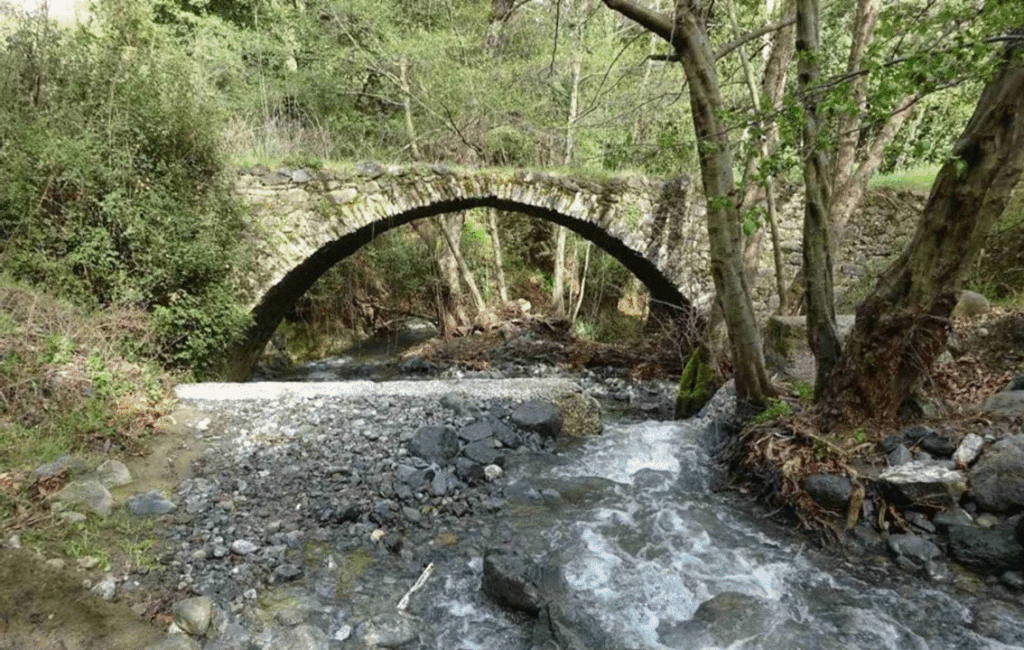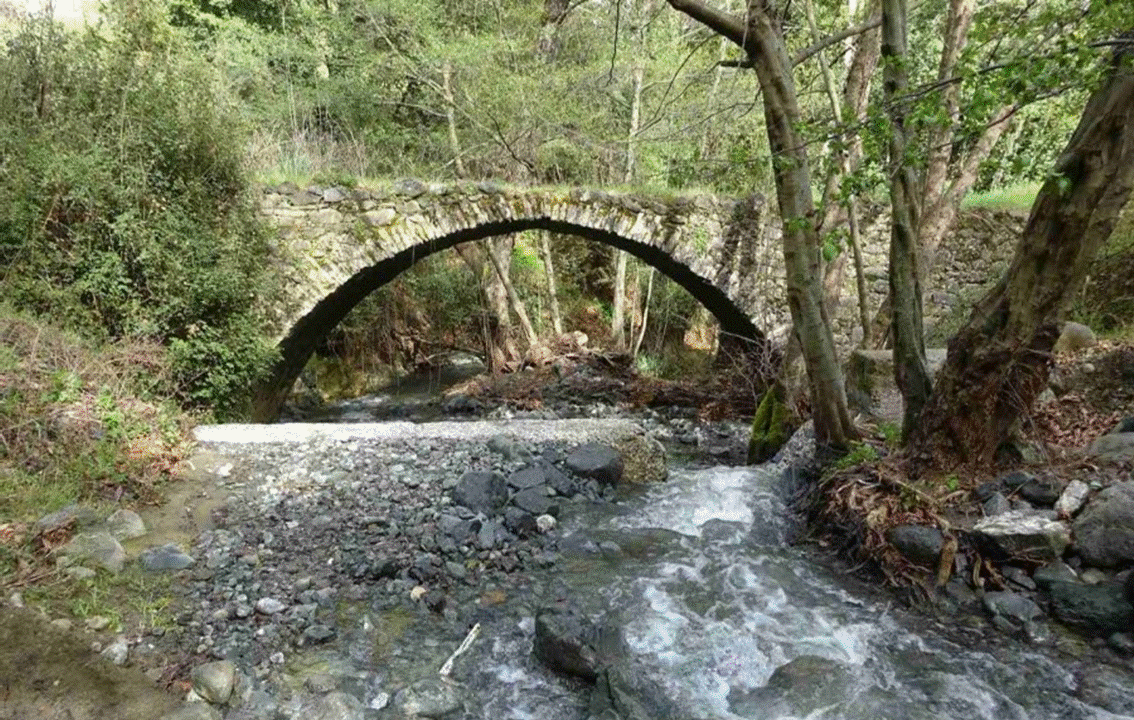
A MOUNTAIN LANDMARK
A RICH HISTORICAL NARRATIVE
The Piskopou Bridge, often referred to as the ‘Piskopos Crossing,’ is a notable architectural and historical landmark. Located by the village of Fini, within the Troodos Mountains, the bridge is a stunning landmark that is set against rural mountainous countryside. At the time of their construction, bridges, such as this, went on to play a crucial role in the daily lives of local inhabitants. They created vital links all over the island that were essential for trade, communication, and military strategy. This landmark embodies the island’s rich historical narrative, architectural ingenuity, and cultural significance.
The name of the bridge is thought to have been derived from one of the bishops of Saint Anargyra. He is said to have often used the crossing to transfer local goods with his mules. The bishop often used the bridge as a halfway resting point and was often found sitting at one end of it by other travellers. With this in mind, the 500-year-old bridge has witnessed centuries of change, while maintaining its role as a critical link within its local community. This bridge also enabled the village of Fini to become a crucial transit zone at the time.

A DEEP HISTORICAL CONTEXT
The Venetians essentially ruled over an empire built on trade. After acquiring Cyprus, they immediately set about constructing bridges and roads throughout the island to help facilitate this. Although the exact date of the bridge’s construction remains unclear, it is thought that it was originally built during the 16th century. It was then rebuilt by the Ottomans in the latter part of the 19th century.
The bridge is characterised by a single distinctive semi-circular stone arch that rises in the centre over the stream. Measuring 8.9 meters, the bridge uses local materials, particularly limestone from the surrounding hills. The bridge employs a tested functional design that is common in both Venetian and Ottoman bridge construction. The total length of the bridge measures approximately 25 meters in length and it has a width of 2.4 meters.

A DEEP CULTURAL CONTEXT
Retaining both its charm and historical identity, the Piscopou Bridge is a classic example of the island’s heritage. It has stood as a silent witness to the changing dynamics on the island since its construction. This has led to the bridge holding cultural and economic significance for the local community for centuries.
The bridge, over the ages, has facilitated not only the movement of people but also the movement of goods. Local farmers and merchants over the ages have relied on the crossing to transport their produce and wares. This has helped to foster a thriving local trade network that has contributed to the economic vitality of the immediate area.

THE PISCOPOU BRIDGE TODAY
Acknowledging the bridge’s historical and cultural value, local authorities and heritage organisations have worked to maintain the structure of the bridge. Promoting sustainable tourism, the bridge has remained an integral part of the local landscape. These efforts have been vital not only for preserving the physical structure but also for promoting awareness and appreciation of the local village’s history.
The bridge today stands as a testament to time, firmly adopting its role as an icon of heritage tourism. The bridge has also helped to highlight the historical significance of bridges such as this and their relation to the broader narrative of Cypriot history. Tourists visiting the bridge often include the village of Fini in their itinerary. This means that they often engage with the local culture meaningfully. The bridge has also become a focal point for several cultural activities, often used to stage local festivals and events. This ultimately brings together residents and visitors in celebration of several Cypriot traditions.

AN EMBLEM OF ENDURING LEGACY
The Piscopou Bridge often attracts the interest of visitors seeking to explore the natural beauty and historical heritage of Cyprus. Its picturesque setting against the backdrop of the Troodos Mountains makes it a popular spot for photography and leisurely walks. The bridge remains an emblem of enduring legacy that also acts as a reminder to all who pass over it.
The bridge also acts as an intricate tapestry of history that defines Cyprus. Along with the bridge, the immediate area around the village of Fini has also been recognised as an area of archaeological importance. Visitors often foster a greater appreciation for the island’s cultural landmarks after a visit to the bridge. This helps to underscore the importance of preserving such sites for future generations. Through continued respect and care for such landmarks, future generations will have the opportunity to connect with the past and understand the importance of the island’s cultural heritage.



